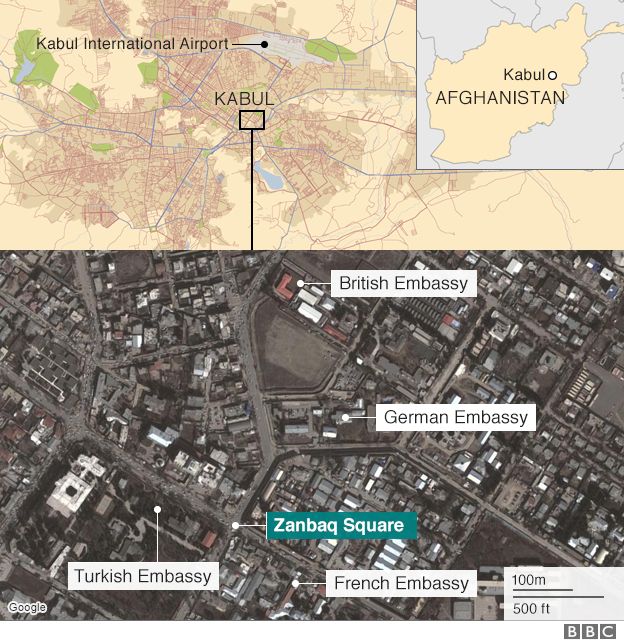Annie
Diamond Member
- Nov 22, 2003
- 50,848
- 4,828
- 1,790
on the order of Michael Yon:
http://counterterrorismblog.org/2006/05/two_days_after_the_kabul_riots.php
http://counterterrorismblog.org/2006/05/two_days_after_the_kabul_riots.php
Two days after the Kabul riot
By Bill Roggio
Kabul, Afghanistan: The city of Kabul has settled down after Monday's violent outbreak that followed a traffic accident involving a runaway U.S. military vehicle and Afghan civilians. The riots were suppressed in eight hours, and the Karzai government instituted an overnight curfew, which has been extended for Wednesday night. While many businesses were closed on Tuesday (I ventured out to pick up a cell phone on Tuesday but the business was closed), there was plenty of traffic and Afghan police and army on the streets. Several long-time residents of Kabul stated today it was business as usual, and the level of security on the streets was not out of the ordinary. Today I saw the streets filled with taxis, civilian cars and bicycles, businesses and markets were open, and the entrepreneurial street vendors selling phone cards, newspapers and other items were everywhere.
The preliminary investigation shows the accident was caused by "a mechanical failure of the vehicles brakes." The convoy was traveling down a steep hill and the vehicle was described as "a heavy cargo truck." From one to six Afghanis were killed in the accident, and up to a dozen were killed and over a hundred wounded in the waves of demonstrations and riots that followed. There are accusations the U.S. Army and Afghan police fired into crowds, but this is still under investigation.
The rioting occurred one of the more socially liberal and less secure neighborhoods in the city. The neighborhood includes Western expatriots, Non-Government Organizations, numerous businesses, restaurants, bars (yes, they exist in Afghanistan) and even a brothel. The Afghan Attorney General resides in the neighborhood. Rioters attacked several Afghan businesses and restaurants, and looted and torched the NGOs CARE Afghanistan and ACTED. The brothel was also set ablaze, and the owner died later that day of a heart attack.
The violence was not Taliban-inspired, but composed mainly of Hazaris. The Haziris are an ethnic group that fought the Taliban under the banner of the Northern Alliance and followers of Ahmad Shah Masood , who was killed by al-Qaeda two days prior to 9-11. Masood's image is prevalent in Kabul. The Hazaris have recently been marginalized by the Karzai administration after they lost their last cabinet post. The rioters were largely young, unemployed males, and there was a significant criminal element involved.
I spoke to several aid workers, contractors and Afghanis about the violence, and their conclusion was the demonstrations were organized, and the traffic accident was merely a catalyst. While there is frustration with driving habits of Western contractors and the military (particularly with the aggressive driving of some security company employees), the subsequent violence was primarily directed at the Karzai administration The neighborhood was targeted because of its relatively light security and the high-profile institutions that are housed there. There is concern among the community about the current security situation in Afghanistan, particularly with the increase in violence in southeastern Iraq and the murder of eight aid workers.
I also spoke to an American woman who lives in the neighborhood where the riots broke out. She was present during the riots and her home was right behind the brothel that was torched. She described how the mobs came in waves. She witnessed three waves before being evacuated, and each successive wave included a progression of violence. The first wave consisted of angry protesters banging on gates and shouting, the second included gunshots, and the third included detonated hand grenades and overturned cars.
There have been questions about the performance of the police during the riots. Jawed Ludin, President Hamid Karzai's Chief of Staff, described the police's performance as "shameful" and stated "we have to strengthen our police." There have been reports that some police joined in the violence. But their performance was not a complete failure. Subduing a violent riot within eight hours is no small feat (see the past and current riots in France), particularly for a relatively new police and military. There has been no follow-on violence two days after the accident. And the American woman who escaped the riots in her neighborhood grudgingly gave credit to the police, which she is critical of for being heavy handed at times.
When her Afghan friend took her out of the home, he put her in the back of a truck and covered her so she would not be seen by the angry crowds. Afghan police nearby noticed this, stopped her friend, questioned them both, and even called over a policeman who spoke English (even though she spoke Farsi) to ensure she was not in danger. The police then provided them an escort out of the danger area. That certainly demonstrates a level of awareness of the situation, organization and an ability to act. Riots by definition are chaotic by nature, and the best of police forces have difficulty containing them.
Radio Programming Note:
I will be on the radio Friday night at 10:30 Eastern / 8:30 Mountain with Rob Breakenridge, host of The World Tonight on AM 770, Calgary, Alberta. To listen online visit AM 770 CHQR and click LISTEN LIVE.


